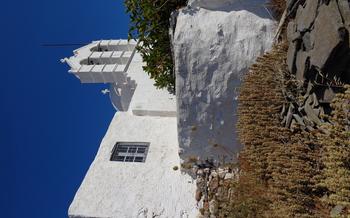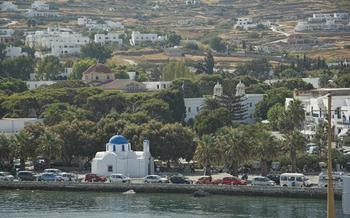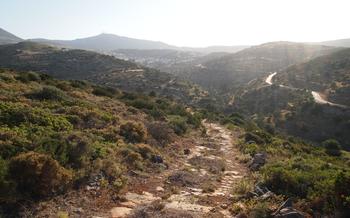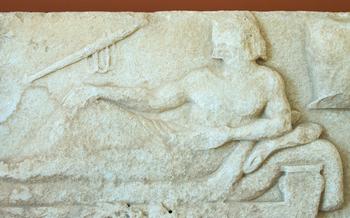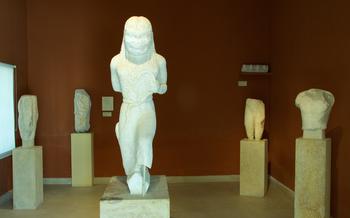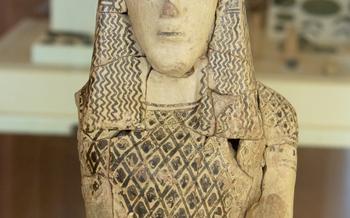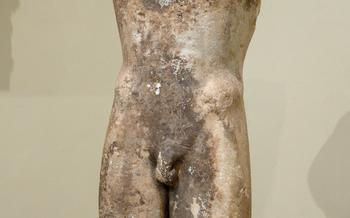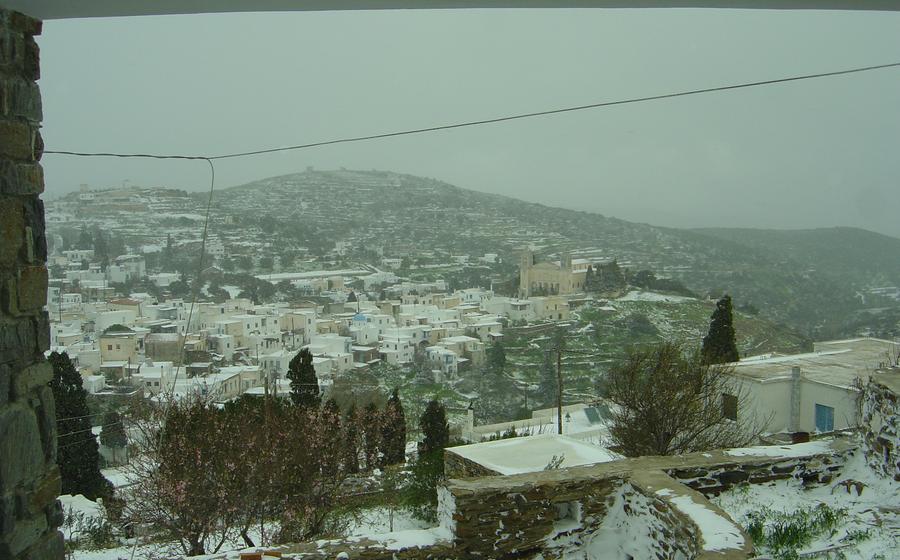
Panagia Ekatontapiliani (The Church of 100 Doors)
- Panagia Ekatontapyliani: A Journey Through the Ages
- Unveiling the Architectural Masterpiece
- A Spiritual Haven
- Stepping into the Past: The Church Museum
- The Church's Connection to the Community
- Panagia Ekatontapyliani in Literature and Art
- A Walk Through History: The Surrounding Area
- Paros' Rich Religious Heritage
- Panagia Ekatontapyliani: A Symbol of Resilience
- Capturing the Essence of Panagia Ekatontapyliani:
- Unforgettable Moments: Personal Anecdotes
- Additional Resources for Exploration
- Insider Tip: Hidden Gem Nearby
Panagia Ekatontapyliani: A Journey Through the Ages
The Panagia Ekatontapyliani, also known as the Church of 100 Doors, stands as a testament to the rich history, architectural prowess, and religious significance of Paros. Its origins can be traced back to the 4th century AD, when the early Christian community on the island sought to build a church dedicated to the Virgin Mary. Over the centuries, the church underwent several expansions, modifications, and renovations, reflecting the changing political, social, and cultural landscapes of Paros.
The church's architectural style is a blend of Byzantine, Venetian, and Cycladic influences, showcasing the diverse cultural heritage of the island. Its imposing stature, intricate carvings, and vibrant frescoes captivate visitors, making it one of the most iconic landmarks in the Aegean.
As a religious sanctuary, the Panagia Ekatontapyliani holds a profound spiritual significance for the people of Paros and beyond. It is dedicated to the Virgin Mary, who is deeply revered and celebrated throughout the Greek Orthodox tradition. The church serves as a place of worship, pilgrimage, and spiritual reflection, attracting devout believers from near and far.
Unveiling the Architectural Masterpiece
Panagia Ekatontapyliani stands as a testament to architectural ingenuity and artistic excellence. Its unique design features, including the iconic 100 doors, have captivated visitors for centuries. The church's exterior is adorned with intricate carvings, sculptures, and mosaics that narrate biblical stories and depict saints and martyrs. Each door is a masterpiece in itself, showcasing a distinct design and often adorned with intricate ironwork and symbolic motifs.
The symbolism behind the 100 doors holds both religious and cultural significance. One interpretation suggests that the doors represent the 100 different ways in which God can be approached or the 100 different paths to salvation. Another interpretation links the doors to the 100 chapters of the Old Testament, emphasizing the church's deep connection to biblical history. The doors also symbolize the welcoming nature of the church, inviting people from all walks of life to seek solace and spiritual guidance within its walls.
Over the centuries, Panagia Ekatontapyliani has undergone several renovations and additions, reflecting the evolution of architectural styles and the changing needs of the community. Despite these changes, the church has retained its original essence and charm. Preservation efforts have been meticulously carried out to ensure that the historical integrity of the building is maintained, while also adapting it to modern-day requirements, such as accessibility and safety features.
A Spiritual Haven
Panagia Ekatontapyliani holds immense religious significance for the people of Paros and beyond. It is considered a sacred site, attracting pilgrims from all over Greece and the world. The church is dedicated to the Virgin Mary, who is deeply revered in the Orthodox Christian tradition. Pilgrims often visit the church to pray, light candles, and leave offerings, seeking blessings and divine intervention.
Throughout the year, the church hosts various religious services and celebrations. On major holidays such as Easter and Christmas, the church is adorned with elaborate decorations, and special services are held, drawing large crowds of worshippers. These celebrations are not only religious events but also important social gatherings where the community comes together to share their faith and traditions.
The church also plays a vital role in the daily lives of the local community. Many residents attend regular services, seeking spiritual guidance and comfort. The church also offers various social and charitable programs, such as soup kitchens and counseling services, supporting those in need and fostering a sense of community and belonging.
Stepping into the Past: The Church Museum
Established in the 19th century, the Panagia Ekatontapyliani Museum is a treasure trove of artifacts that narrate the rich history of the church and the island of Paros. Housed within the church complex, the museum invites visitors to embark on a journey through time.
The exhibits showcase a diverse collection of religious icons, manuscripts, and vestments, each piece offering a glimpse into the spiritual traditions of Paros. Among the highlights are exquisite Byzantine icons dating back to the 12th century, adorned with intricate gold leaf and vibrant colors. These icons depict scenes from the Bible and the lives of saints, providing a visual testament to the deep faith of the local community.
In addition to religious artifacts, the museum also houses a collection of historical documents and photographs that shed light on the church's role in the social and cultural life of Paros. Visitors can learn about the church's involvement in the Greek War of Independence and its contributions to the island's educational and cultural development.
The Panagia Ekatontapyliani Museum is not just a repository of artifacts; it is a living testament to the enduring legacy of the church. Through its exhibits, the museum invites visitors to delve into the past and gain a deeper understanding of the spiritual and cultural heritage of Paros.
The Church's Connection to the Community
Panagia Ekatontapyliani is deeply intertwined with the fabric of the local community. It serves as a spiritual and cultural beacon, playing a pivotal role in fostering a sense of unity and belonging among the residents of Paros. The church is a cornerstone of community life, actively participating in numerous celebrations and events throughout the year. These festivities bring people together, creating opportunities for socialization, cultural exchange, and the preservation of local traditions.
Beyond its religious significance, Panagia Ekatontapyliani also contributes to the community through various outreach programs. The church organizes charitable initiatives, provides assistance to those in need, and promotes educational opportunities for the youth. It serves as a gathering place for historical meetings, discussions, and cultural events, fostering a sense of shared heritage and pride among the locals. Additionally, the church's presence attracts a steady stream of visitors and pilgrims, contributing to the local economy through tourism and the promotion of local businesses.
Panagia Ekatontapyliani in Literature and Art
inspired numerous works of literature, poetry, and folklore. Local tales and legends weave intricate narratives around the church, intertwining it with the island's cultural heritage. Renowned Greek poets, such as Odysseas Elytis and George Seferis, have immortalized the church's beauty and spiritual significance in their verses.
Artistic representations of Panagia Ekatontapyliani abound, capturing its architectural splendor and religious essence. Paintings, sculptures, and intricate crafts showcase the church's unique features and its profound impact on the local community. These artistic expressions serve as a testament to the enduring legacy of Panagia Ekatontapyliani, transcending time to preserve its essence for generations to come.
Moreover, the church's distinctive architecture and historical significance have made it a popular subject for cultural exploration. Documentaries, short films, and television features have delved into the church's past, shedding light on its construction, religious significance, and role in shaping the identity of Paros. These multimedia productions have played a vital role in promoting the church's heritage and encouraging visitors to discover its timeless beauty.
A Walk Through History: The Surrounding Area
The Panagia Ekatontapyliani church stands as a testament to the rich history and cultural heritage of the island of Paros. Beyond the church's walls, the surrounding area is a treasure trove of historical landmarks and sites, inviting visitors to delve deeper into the island's past.
A short stroll from the church leads to the picturesque old town of Parikia, where visitors can wander through narrow cobblestone streets, admire traditional Cycladic architecture, and discover hidden gems like the Venetian castle and the Archaeological Museum.
Just outside the town, the ruins of the ancient city of Paros offer a glimpse into the island's classical past. Explore the remains of temples, theaters, and fortifications, and immerse yourself in the stories of ancient Greece.
The surrounding area is also home to several other churches and monasteries, each with its own unique history and charm. Take a leisurely walk along the coast to visit the charming chapels of Agios Nikolaos and Agia Marina, or venture inland to discover hidden gems like the Monastery of Agios Ioannis Theologos.
To fully appreciate the rich tapestry of Paros' history, consider joining a guided tour or hiring a local guide. These experts can provide insights into the island's past, point out hidden treasures, and bring the stories of Paros to life.
Paros' Rich Religious Heritage
Paros, with its diverse history and cultural tapestry, is home to a wealth of religious landmarks beyond the iconic Panagia Ekatontapyliani. Scattered across the island are numerous churches, monasteries, and chapels, each holding its own unique story and significance.
The Church of Agios Nikolaos, located in the picturesque village of Naoussa, is a testament to the island's maritime heritage. Dedicated to the patron saint of sailors, it offers stunning views of the Aegean Sea and is a popular destination for both locals and visitors.
The Monastery of Agios Ioannis Theologos, perched atop a hill overlooking the village of Lefkes, provides a glimpse into the ascetic life of the Eastern Orthodox monks. Founded in the 11th century, it features intricate frescoes, a charming courtyard, and a serene atmosphere that invites contemplation.
The Church of Agia Triada, situated near the village of Marpissa, is known for its beautiful Byzantine architecture and well-preserved icons. It is a popular pilgrimage site, particularly during the annual festival held in honor of the Holy Trinity.
These are just a few examples of the many religious treasures that Paros holds. Exploring these sacred spaces offers a deeper understanding of the island's rich cultural heritage and the profound role that religion has played in shaping its identity.
Panagia Ekatontapyliani: A Symbol of Resilience
Throughout its existence, Panagia Ekatontapyliani has faced numerous challenges, including natural disasters and conflicts. However, it has remarkably survived and endured, standing as a testament to the resilience and adaptability of human spirit.
The church has undergone several restoration efforts over the centuries to maintain its structural integrity and preserve its cultural significance. These efforts involved meticulous repairs, restoration of damaged artwork, and the integration of modern conservation techniques to protect the church from further deterioration.
Preserving cultural heritage is of utmost importance, and Panagia Ekatontapyliani serves as a reminder of the enduring value of history. The church's survival through various adversities highlights the significance of safeguarding our cultural heritage for future generations.
Moreover, the church's resilience symbolizes the strength and determination of the local community. It represents their ability to overcome challenges, adapt to changing circumstances, and maintain their cultural identity. Panagia Ekatontapyliani stands as a beacon of hope, reminding us of the enduring power of heritage and the resilience of the human spirit.
Capturing the Essence of Panagia Ekatontapyliani:
The beauty of Panagia Ekatontapyliani transcends mere architectural appreciation. Its spiritual aura and historical significance beckon photographers to capture its essence through the lens. To fully embrace this opportunity, consider the following tips:
-
Embrace Natural Light: The interplay of light and shadow on the church's exterior creates a picturesque canvas. Arrive early in the morning or late in the afternoon to harness the golden hues that enhance the church's grandeur.
-
Explore Different Perspectives: Don't limit yourself to frontal shots. Circumnavigate the church to discover unique angles that showcase its intricate details from various vantage points.
-
Respect the Sacred Space: While photography is encouraged, remember that Panagia Ekatontapyliani is an active place of worship. Be mindful of religious ceremonies and avoid using flash or creating disturbances that may disrupt the spiritual atmosphere.
-
Engage with the Locals: Engage with the friendly locals, who often share fascinating stories about the church. Their insights can add depth and context to your photographic journey.
-
Share Your Experience: Share your captured moments on social media, using relevant hashtags to connect with fellow travelers and inspire others to explore this architectural gem. Remember to tag the church's official social media accounts to contribute to its online presence and promote responsible tourism.
Unforgettable Moments: Personal Anecdotes
My first visit to Panagia Ekatontapyliani was a profound experience that ignited a deep connection. As I stepped into the sacred space, the serene atmosphere and intricate architecture transported me back in time. The palpable sense of history and spirituality enveloped me, evoking a sense of awe and reverence.
One memorable encounter occurred during a traditional Greek Orthodox service. The melodious chanting of the choir, the rhythmic swaying of the congregation, and the fragrant incense created an otherworldly ambiance. Witnessing the deep devotion and shared faith of the local community was a moving experience that left an indelible mark on my soul.
Another cherished memory is a conversation with an elderly local woman who shared stories of her childhood spent playing in the church's courtyard. Her vivid recollections of the church's role in community celebrations, weddings, and baptisms brought the church's rich history to life, reminding me of the enduring bond between the church and the people of Paros.
These personal anecdotes encapsulate the essence of Panagia Ekatontapyliani's significance. It is not merely a historical monument but a living testament to the enduring power of faith, culture, and community. The memories created within its sacred walls are cherished treasures that I will forever hold dear.
Additional Resources for Exploration
To delve deeper into the history, significance, and cultural impact of Panagia Ekatontapyliani, I highly recommend the following resources:
- "The Church of 100 Doors: A Journey Through Time" by Dr. Ioannis Arvanitis provides a comprehensive historical account of the church, its architecture, and its role in Greek Orthodox Christianity.
- The official website of the Paros Diocese [link] offers detailed information about the church, its services, and upcoming events.
- For a visual exploration of Panagia Ekatontapyliani's stunning architecture and artwork, visit the online photo gallery [link] maintained by the Greek Ministry of Culture.
- To connect with other enthusiasts and learn about ongoing preservation efforts, join the "Friends of Panagia Ekatontapyliani" Facebook group [link].
- For a truly immersive experience, consider participating in one of the guided tours offered by the local tourism board. These tours provide in-depth insights into the church's history, religious significance, and architectural features.
Engaging with the local community is an essential part of understanding Panagia Ekatontapyliani's enduring legacy. Strike up conversations with the friendly locals, attend a traditional Greek Orthodox service, or savor the delicious cuisine at one of the nearby tavernas. Their stories and experiences will offer a unique perspective on the church's deep connection to the island's culture and identity.
Insider Tip: Hidden Gem Nearby
After exploring Panagia Ekatontapyliani, take a short walk to the charming village of Lefkes, nestled amidst picturesque hills. Immerse yourself in the traditional architecture, wander through narrow cobblestone streets, and soak in the tranquil atmosphere. Don't miss the Folklore Museum of Lefkes, where you can delve into the rich cultural heritage of Paros, uncovering the island's past through captivating exhibits. As you stroll around, indulge in local delicacies at one of the traditional tavernas, savoring the authentic flavors of Paros while enjoying breathtaking views of the Aegean Sea. This hidden gem is a perfect complement to your visit to Panagia Ekatontapyliani, offering a glimpse into the authentic side of Paros and leaving you with lasting memories of your journey.
